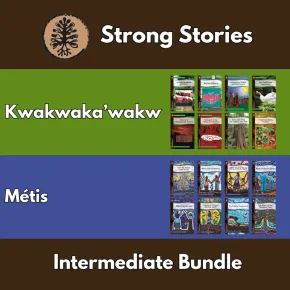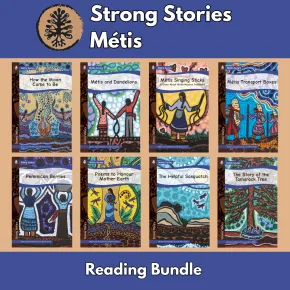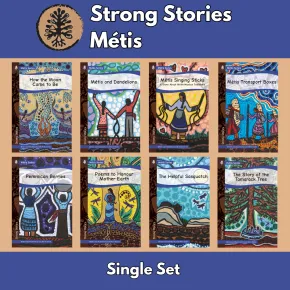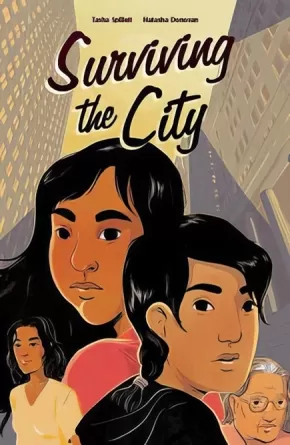
Métis
151
-
165
of
214 Results;
Sort By
Go To
of 15
Pemmican Wars
$21.95
Artists:
Format:
Paperback
Text Content Territories:
Indigenous Canadian; Métis;
ISBN / Barcode: 9781553796787
Synopsis:
Synopsis:
Echo Desjardins, a 13-year-old Métis girl adjusting to a new home and school, is struggling with loneliness while separated from her mother. Then an ordinary day in Mr. Bee’s history class turns extraordinary, and Echo’s life will never be the same. During Mr. Bee’s lecture, Echo finds herself transported to another time and place—a bison hunt on the Saskatchewan prairie—and back again to the present. In the following weeks, Echo slips back and forth in time. She visits a Métis camp, travels the old fur-trade routes, and experiences the perilous and bygone era of the Pemmican Wars.
Educator & Series Information
Recommended for ages 12+ by the publisher.
Pemmican Wars is the first graphic novel in the A Girl Called Echo series.
Books in this series include:
Volume 1: Pemmican Wars
Volume 2: Red River Resistance
Volume 3: Northwest Resistance
Volume 4: Road Allowance Era
The Canadian Indigenous Books for School list recommends this for Grades 5-12 for these subject areas: Arts Education, English Language Arts, Social Studies.
This book is available in French: Elle s'appelle Echo Tome 1: La guerre du Pemmican
Additional Information
48 pages | 6.50" x 10.00"
Red River Resistance
$21.95
Artists:
Format:
Paperback
Text Content Territories:
Indigenous Canadian; Métis;
ISBN / Barcode: 9781553797470
Synopsis:
Synopsis:
Echo Desjardins is adjusting to her new home, finding friends, and learning about Métis history. She just can’t stop slipping back and forth in time. One ordinary afternoon in class, Echo finds herself transported to the banks of the Red River in the summer of 1869. All is not well in the territory as Canadian surveyors have arrived to change the face of territory, and Métis families, who have lived there for generations, are losing access to their land. As the Resistance takes hold, Echo fears for her friends and the future of her people in the Red River Valley.
Educator & Series Information
Recommended for grades 5 to 9.
Red River Resistance is volume two in the graphic novel series, A Girl Called Echo, by Katherena Vermette.
Books in this series include:
Volume 1: Pemmican Wars
Volume 2: Red River Resistance
Volume 3: Northwest Resistance
Volume 4: Road Allowance Era
Recommended in the Canadian Indigenous Books for Schools 2019-2020 resource list as being useful for grades 5-12 with regard to these subjects: English Language Arts, Art Education, Social Studies.
This book is available in French: Elle s'appelle Echo Tome 2: La guerre du Pemmican
Additional Information
47 pages | 6.50" x 10.00"
Strong Stories - Intermediate includes Kwakwaka’wakw and Métis - Single Set Bundle
 $143.28 $159.20
$143.28 $159.20

Text Content Territories:
Indigenous Canadian; First Nations; Kwakwaka'wakw (Kwakiutl); Métis;
ISBN / Barcode: 9781771746670
Synopsis:
Synopsis:
This Intermediate bundle features one copy each of two Strong Stories sets: Kwakwaka’wakw and Métis (16 books total).
Kwakwaka’wakw Strong Stories include the following from authors Sally Williams and Bobbie Wildman and illustrator Lou-ann Neel:
A Kwakwaka’wakw Potlatch
Button Blankets
Hereditary Chiefs and Matriarchs
Our Traditional Medicines
Planning a Kwakwaka’wakw Potlatch
Strength in Our “Ways of Knowing”
The Cedar Tree Our Culture, Our Tree
Traditional Berry Picking
Métis Strong Stories include the following from author and illustrator Leah Marie Dorion:
How the Moon Came to Be
Métis and Dandelions
Métis Singing Sticks: A Story About Métis Musical Traditions
Pemmican Berries
Poems to Honour Mother Earth
The Helpful Sasquatch
Métis Transport Boxes
The Story of the Tamarack Tree
Reading levels span from grade 4 to grade 6. Recommended for intermediate students.
Additional Information
ISBN: 9781771746670
Strong Stories Métis - Reading Bundle
 $429.84 $477.60
$429.84 $477.60

Text Content Territories:
Indigenous Canadian; Métis;
ISBN / Barcode: 9781771746700
Synopsis:
Synopsis:
Bundle includes all 8 titles, 6 of each, in the Strong Stories Métis series (48 books total).
Recommended for intermediate students.
Books in the Métis series include the following from author and illustrator Leah Marie Dorion:
How the Moon Came to Be
Métis and Dandelions
Métis Singing Sticks: A Story About Métis Musical Traditions
Pemmican Berries
Poems to Honour Mother Earth
The Helpful Sasquatch
Métis Transport Boxes
The Story of the Tamarack Tree
Additional Information
ISBN: 9781771746700
Strong Stories Métis - Single Set Bundle
 $71.64 $79.60
$71.64 $79.60

Text Content Territories:
Indigenous Canadian; Métis;
ISBN / Barcode: 9781771745871
Synopsis:
Synopsis:
Own the entire set of Métis Strong Stories! (8 books total)
Recommended for intermediate students.
Books in the Métis series include the following from author and illustrator Leah Marie Dorion:
How the Moon Came to Be
Métis and Dandelions
Métis Singing Sticks: A Story About Métis Musical Traditions
Pemmican Berries
Poems to Honour Mother Earth
The Helpful Sasquatch
Métis Transport Boxes
The Story of the Tamarack Tree
Additional Information
ISBN: 9781771745871
Strong Stories Métis: How the Moon Came to Be
 $9.95
$9.95

Artists:
Format:
Paperback
Text Content Territories:
Indigenous Canadian; Métis;
ISBN / Barcode: 9781771743143
Synopsis:
Synopsis:
A beautiful traditional Métis story about the creation of the moon. How did Mother Earth and Grandmother Moon come to be named as they are? Do you know why you have the name you were given?
Educator & Series Information
Recommended for intermediate students (grades 4-6).
How the Moon Came to Be is part of the Strong Stories: Métis series. Strong Stories focus on different First Nation territories from across Canada and the United States. These stories reflect the belief that our stories are the roots of our people, our lands and our cultures. It is from our stories that we grow and become strong and proud.
Additional Information
16 pages | 6.00" x 9.00" | ISBN: 9781771743143
Strong Stories Métis: Métis and Dandelions
 $9.95
$9.95

Artists:
Format:
Paperback
Text Content Territories:
Indigenous Canadian; Métis;
ISBN / Barcode: 9781771743150
Synopsis:
Synopsis:
Both the Métis people and dandelions have great resiliency in their ability to survive. They both have similar characteristics. What is it about dandelions that makes them strong and resilient?
Educator & Series Information
Recommended for intermediate students (grades 4-6).
Métis and Dandelions is part of the Strong Stories: Métis series. Strong Stories focus on different First Nation territories from across Canada and the United States. These stories reflect the belief that our stories are the roots of our people, our lands and our cultures. It is from our stories that we grow and become strong and proud.
Additional Information
16 pages | 6.00" x 9.00" | ISBN: 9781771743150
Strong Stories Métis: Métis Singing Sticks: A Story About Métis Musical Traditions
$9.95
Artists:
Format:
Paperback
Text Content Territories:
Indigenous Canadian; Métis;
ISBN / Barcode: 9781771743167
Synopsis:
Synopsis:
Métis Singing Sticks are more than musical instruments, they are also special family time spent together. Join Leah as she shares a family story. What is a special family time that your family has?
Educator & Series Information
Recommended for intermediate students (grades 4-6).
A Story About Métis Musical Traditions is part of the Strong Stories: Métis series. Strong Stories focus on different First Nation territories from across Canada and the United States. These stories reflect the belief that our stories are the roots of our people, our lands and our cultures. It is from our stories that we grow and become strong and proud.
Additional Information
16 pages | 6.00" x 9.00" | ISBN: 9781771743167
Strong Stories Métis: Métis Transport Boxes
 $9.95
$9.95

Artists:
Format:
Paperback
Text Content Territories:
Indigenous Canadian; Métis;
ISBN / Barcode: 9781771743174
Synopsis:
Synopsis:
People need boxes to put things into when moving from one place to another. There are many kinds of boxes today. Long ago, there were only wooden boxes which were all handmade. What kinds of boxes have you seen?
Educator & Series Information
Recommended for intermediate students (grades 4-6).
Métis Transport Boxes is part of the Strong Stories: Métis series. Strong Stories focus on different First Nation territories from across Canada and the United States. These stories reflect the belief that our stories are the roots of our people, our lands and our cultures. It is from our stories that we grow and become strong and proud.
Additional Information
16 pages | 6.00" x 9.00" | ISBN: 9781771743174
Strong Stories Métis: Pemmican Berries
 $9.95
$9.95

Artists:
Format:
Paperback
Text Content Territories:
Indigenous Canadian; Métis;
ISBN / Barcode: 9781771743181
Synopsis:
Synopsis:
Long ago, pemmican was a staple food for Métis people. At that time, it was made with dried and crushed buffalo meat mixed with grease and dried berries. Pemmican could last through the winter months in storage. What is a type of food that you know of that can last a long time?
Educator & Series Information
Recommended for intermediate students (grades 4-6).
Pemmican Berries is part of the Strong Stories: Métis series. Strong Stories focus on different First Nation territories from across Canada and the United States. These stories reflect the belief that our stories are the roots of our people, our lands and our cultures. It is from our stories that we grow and become strong and proud.
Additional Information
16 pages | 6.00" x 9.00" | ISBN: 9781771743181
Strong Stories Métis: Poems to Honour Mother Earth
 $9.95
$9.95

Artists:
Format:
Paperback
Text Content Territories:
Indigenous Canadian; Métis;
ISBN / Barcode: 9781771743198
Synopsis:
Synopsis:
Leah Marie Dorion’s poetry reflects her deep connection to Mother Earth, which she has had since she was a child. Each poem gently recognizes all that is around us and the importance of being respectful. What is one way that you show respect to Mother Earth?
Educator & Series Information
Recommended for intermediate students (grades 4-6).
Poems to Honour Mother Earth is part of the Strong Stories: Métis series. Strong Stories focus on different First Nation territories from across Canada and the United States. These stories reflect the belief that our stories are the roots of our people, our lands and our cultures. It is from our stories that we grow and become strong and proud.
Additional Information
16 pages | 6.00" x 9.00" | ISBN: 9781771743198
Strong Stories Métis: The Helpful Sasquatch
 $9.95
$9.95

Artists:
Format:
Paperback
Text Content Territories:
Indigenous Canadian; Métis;
ISBN / Barcode: 9781771743204
Synopsis:
Synopsis:
A playful story about how Sasquatch is always being helpful. Sasquatch is honoured with an offering of food to show gratitude. What is something that you do to show gratitude?
Educator & Series Information
Recommended for intermediate students (grades 4-6).
The Helpful Sasquatch is part of the Strong Stories: Métis series. Strong Stories focus on different First Nation territories from across Canada and the United States. These stories reflect the belief that our stories are the roots of our people, our lands and our cultures. It is from our stories that we grow and become strong and proud.
Additional Information
16 pages | 6.00" x 9.00" | ISBN: 9781771743204
Strong Stories Métis: The Story of the Tamarack Tree
 $9.95
$9.95

Artists:
Format:
Paperback
Text Content Territories:
Indigenous Canadian; Métis;
ISBN / Barcode: 9781771743211
Synopsis:
Synopsis:
Creator advised us not to compare ourselves to each other. We all have a special place within the circle of life. What do you think happens when Tamarack seeks the attention of the Muskeg people?
Educator & Series Information
Recommended for intermediate students (grades 4-6).
The Story of the Tamarack Tree is part of the Strong Stories: Métis series. Strong Stories focus on different First Nation territories from across Canada and the United States. These stories reflect the belief that our stories are the roots of our people, our lands and our cultures. It is from our stories that we grow and become strong and proud.
Additional Information
16 pages | 6.00" x 9.00" | ISBN: 9781771743211
Surviving the City Vol. 1
$21.95
Artists:
Format:
Paperback
Text Content Territories:
Indigenous Canadian; First Nations; Cree (Nehiyawak); Anishinaabeg;
ISBN / Barcode: 9781553797562
Synopsis:
Synopsis:
Tasha Spillett’s graphic novel debut, Surviving the City, is a story about womanhood, friendship, colonialism, and the anguish of a missing loved one.
Miikwan and Dez are best friends. Miikwan is Anishinaabe; Dez is Inninew. Together, the teens navigate the challenges of growing up in an urban landscape – they’re so close, they even completed their Berry Fast together. However, when Dez’s grandmother becomes too sick, Dez is told she can’t stay with her anymore. With the threat of a group home looming, Dez can’t bring herself to go home and disappears. Miikwan is devastated, and the wound of her missing mother resurfaces. Will Dez’s community find her before it’s too late? Will Miikwan be able to cope if they don’t?
Awards
- Winner of the 2019 Indigenous Voices Award for Works in an Alternative Format
- Co-winner of the Eileen McTavish Sykes Award for Best First Book by a Manitoba Author
- Winner of the Manuela Dias Design and Illustration Award, Graphic Novel category
Educator & Series Information
Recommended Grades: 7-12.
This graphic novel is part of the Surviving the City series, which is also part of the Debwe Series.
The Surviving the City series includes these titles:
- Surviving the City
- From the Roots Up
- We Are the Medicine
Recommended in the Canadian Indigenous Books for Schools 2019-2020 resource list for grades 10 to 12 for English Language Arts and Social Studies.
This book could be triggering for some readers as it contains mature content and focuses on issues such as Missing and Murdered Indigenous Women and Girls.
A Teacher Guide is available: Surviving the City Teacher Guide: Exploring Identity, Allyship, and Social Action for Meaningful Change in Grades 7-12
Additional Information
56 pages | 6.50" x 10.00"
The Orange Shirt Story
$19.99
Artists:
Format:
Paperback
Text Content Territories:
Indigenous Canadian; First Nations; Salish; Interior Salish; Secwepemc (Shuswap); Stswecem'c Xgat'tem;
ISBN / Barcode: 9780993869495
Synopsis:
Synopsis:
When Phyllis Webstad (nee Jack) turned six, she went to the residential school for the first time. On her first day at school, she wore a shiny orange shirt that her Granny had bought for her, but when she got to the school, it was taken away from her and never returned. This is the true story of Phyllis and her orange shirt. It is also the story of Orange Shirt Day (an important day of remembrance for First Nations and non First Nations Canadians).
Reviews
"The book includes a brief history of the Secwepemc people, St. Joseph’s Residential School, and a glossary and conversation starters. A must for elementary school teachers. " - Canadian Indigenous Books for Schools 2020/2021
Educator Information
Recommended for grades 2 to 5.
This resource is also available in French: The Orange Shirt Story (French) / L'histoire Du Chandail Orange
Recommended in the Canadian Indigenous Books for Schools 2020/2021 resource list for grades 1-5 in the areas of English Language Arts, Social Studies, and Career Education.
Additional Information
8.5" x 11" | 44 pages
Sort By
Go To
of 15





















